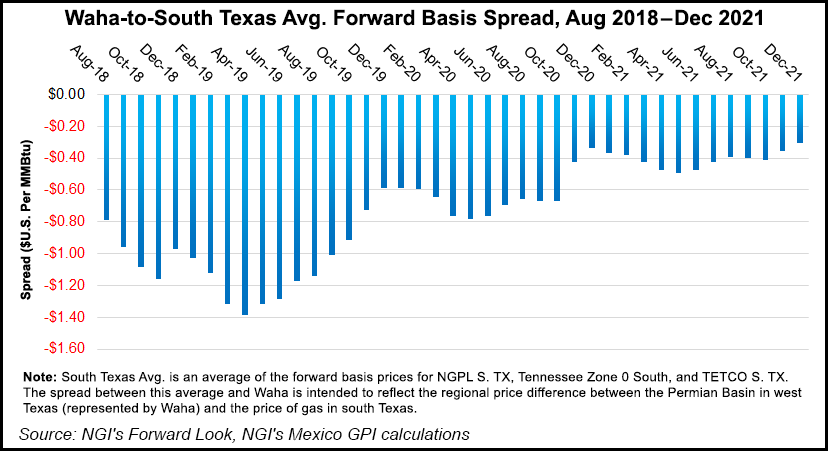Infrastructure | NGI All News Access
Mexico Natural Gas Demand Factoring into Kinder Morgan’s Growth
Kinder Morgan Inc. could have more to say about moving forward with plans for its second greenfield pipeline to serve the Permian Basin in the coming months as it works to alleviate takeaway constraints and match its customers with attractive markets south of the Texas border.

It was only in December that KMI, one of the United States’ largest transporters of natural gas, made a final investment decision to build the now fully subscribed Gulf Coast Express Pipeline (GCX), which would move 2 Bcf/d from the Permian to the South Texas hub at Agua Dulce near Corpus Christi if it comes online as expected in October 2019.
But the company’s second effort to tap into more of the Permian’s booming oil and associated natural gas production, the Permian Highway Pipeline Project, is already accelerating, with CEO Steven Kean noting during a second earnings call that “customer sign-ups and customer interest have been coming very fast.
The $2 billion Permian Highway project is designed to transport up to 2 Bcf/d of natural gas through 430 miles of 42-inch diameter pipeline from the Waha hub in West Texas to the U.S. Gulf Coast and Mexico markets. Kean said the company might have more to share about moving forward with the project by the end of September. KMI is partnering with EagleClaw Midstream Ventures LLC and Apache Corp., one of the Permian’s biggest gas players, on the pipeline. But the project is so attractive, he added, that KMI would consider funding more of it if its partners could not.
Swift progress on both the Permian Highway and GCX projects, Kean said, speak to the “robust growth in the production out of the Permian.” He added that it also shows “the value of our downstream network in terms of giving customers good alternatives to get their gas to the Houston market, power demand, petrochemical, as well as liquefied natural gas (LNG) and Mexico exports.”
While KMI has holdings in many of the key U.S. gas basins, it’s long been focused on the Gulf Coast. Kean said Texas is currently the biggest piece of KMI’s growth prospects, indicating that American gas producers are eager to push their volumes to the Gulf Coast and farther south.
Management said U.S. gas demand, including net exports of LNG and net exports to Mexico, will increase 39% to nearly 112 Bcf/d by 2027. Beyond the Permian Highway, KMI is working to move more gas to Mexico on the El Paso Natural Gas system and the Sierrita Gas Pipeline, among others.
Overall, KMI’s natural gas pipeline segment’s performance in the second quarter was up 11% year/year. The company again reported an increase in transported volumes, up 12% from 2Q2017. President Kimberly Allen Dang attributed the growth on KMI’s large diameter pipes to increased supplies from the Permian and Denver-Julesburg basins, growing Mexican exports and increased power demand from projects that were placed into service. Gas gathering volumes in the second quarter were also up 7% from the year-ago period.
KMI reported revenue of $3.4 billion for the second quarter, nearly flat from $3.3 billion in 2Q2017. Reported distributable cash flow was $1.1 billion (50 cents/share) for the period, a 9% increase year/year. However, KMI reported a net loss of $180 million (minus 8 cents) compared with net income of $337 million (15 cents) in the year-ago period. The net loss was attributed to Oklahoma gathering and processing impairments.
© 2024 Natural Gas Intelligence. All rights reserved.
ISSN © 2577-9877 | ISSN © 2577-9966 |
